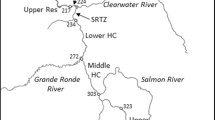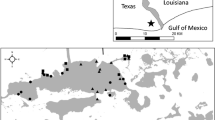Abstract
Predation is likely the primary source of mortality for juvenile penaeid shrimp and, therefore, a key factor driving their population dynamics. We sampled juvenile penaeids and their potential predators in a salt marsh from July to August 2012 to examine the impact of these predators and possible size-selective predation on the shrimp population. We quantified predator impact using the frequency of occurrence (FO) index and a relative predation index (RPI) that accounts for predator abundance and the number of shrimp consumed per individual predator. Size selectivity was assessed by comparing the size distribution of shrimp in the study area to the size distribution of shrimp removed from predator stomachs. Two penaeid species, white shrimp Litopenaeus setiferus and brown shrimp Farfantepenaeus aztecus, were collected, and most (86%) were juvenile white shrimp ≤ 12 mm carapace length. Spotted seatrout Cynoscion nebulosus, which consumed relatively large shrimp, was the most important predator based on the FO index. Bay whiff Citharichthys spilopterus, which ate the smallest shrimp, was the most important predator based on the RPI. The size distribution of shrimp removed from predator stomachs differed from those collected in the study area; the smallest shrimp were disproportionally more abundant in predator stomachs. Using the RPI, we identified some potentially important predators (e.g., bay whiff) that may impact shrimp populations by consuming the smallest shrimp in estuarine nurseries. Our approach could be useful for examining predator impacts on other populations of juvenile penaeids and more generally for any prey consumed by fish predators.

Similar content being viewed by others
References
Baker, R., and M. Sheaves. 2009. Overlooked small and juvenile piscivores dominate shallow-water estuarine “refuges” in tropical Australia. Estuarine, Coastal and Shelf Science 85 (4): 618–626.
Baker, R., M. Fujiwara, and T.J. Minello. 2014. Juvenile growth and mortality effects on white shrimp Litopenaeus setiferus population dynamics in the northern Gulf of Mexico. Fisheries Research 155: 74–82.
Brewer, D.T., S.J.M. Blaber, J.P. Salini, and M.J. Farmer. 1995. Feeding ecology of predatory fishes from Groote Eylandt in the Gulf of Carpentaria, Australia, with special reference to predation on penaeid prawns. Estuarine, Coastal and Shelf Science 40 (5): 577–600.
Chipps, S.R., and J.E. Garvey. 2007. Assessment of diets and feeding patterns. In Analysis and interpretation of freshwater fisheries data, ed. C.S. Guy and M.L. Brown, 473–514. Bethesda: American Fisheries Society.
Dall, W., B.J. Hill, P.C. Rothlisberg, and D.J. Sharples. 1990. The biology of the Penaeidae. Advances in Marine Biology 27: 1–484.
Darnell, R.M. 1958. Food habits of fishes and larger invertebrates of Lake Pontchartrain, Louisiana, an estuarine community. Publications of the Institute of Marine Science 5: 353–416.
Diener, R.A., A. Inglis, and G.B. Adams. 1974. Stomach contents of fishes from Clear Lake and tributary waters, a Texas estuarine area. Contributions in Marine Science 18: 7–17.
Ditty, J.G. 2011. Young of Litopenaeus setiferus, Farfantepenaeus aztecus and F. duorarum (Decapoda: Penaeidae): a re-assessment of characters for species discrimination and their variability. Journal of Crustacean Biology 31 (3): 458–467.
Facendola, J.J., and F.S. Scharf. 2012. Seasonal and ontogenetic variation in the diet and daily ration of estuarine red drum as derived from field-based estimates of gastric evacuation and consumption. Marine and Coastal Fisheries: Dynamics, Management, and Ecosystem Science 4 (1): 546–559.
Haas, H.L., E.C. Lamon III, K.A. Rose, and R.F. Shaw. 2001. Environmental and biological factors associated with the stage-specific abundance of brown shrimp (Penaeus aztecus) in Louisiana: applying a new combination of statistical techniques to long-term monitoring data. Canadian Journal of Fisheries and Aquatic Sciences 58 (11): 2258–2270.
Haywood, M.D.E. 1995. Rates at which post-larval prawns are digested by a small predatory fish and the implications for predation studies. Journal of Fish Biology 47 (2): 337–340.
Hope, A.C.A. 1968. A simplified Monte Carlo significance test procedure. Journal of the Royal Statistical Society. Series B 30: 582–598.
Hyslop, E.J. 1980. Stomach contents analysis—a review of methods and their application. Journal of Fish Biology 17 (4): 411–429.
Knudsen, E.E., W.H. Herke, and J.M. Mackler. 1977. The growth rate of marked juvenile brown shrimp, Penaeus aztecus, in a semi-impounded Louisiana coastal marsh. Proceedings of the Gulf and Caribbean Fisheries Institute 29: 144–159.
Kristiansen, T.S., and T. Svåsand. 1998. Effect of size-selective mortality on growth of coastal cod illustrated by tagging data and an individual-based growth and mortality model. Journal of Fish Biology 52 (4): 688–705.
Lowe, M.R., and M.S. Peterson. 2015. Body condition and foraging patterns of nekton from salt marsh habitats arrayed along a gradient of urbanization. Estuaries and Coasts 38 (3): 800–812.
Mace, M., III, and L.P. Rozas. 2015. Estimating natural mortality rates of juvenile white shrimp Litopenaeus setiferus. Estuaries and Coasts 38 (5): 1580–1592.
Mace, M., III, and L.P. Rozas. 2017. Population dynamics and secondary production of juvenile white shrimp (Litopenaeus setiferus) along an estuarine salinity gradient. Fishery Bulletin 115: 74–88.
Minello, T.J., and R.J. Zimmerman. 1983. Fish predation on juvenile brown shrimp, Penaeus aztecus Ives: the effect of simulated Spartina structure on predation rates. Journal of Experimental Marine Biology and Ecology 72 (3): 211–231.
Minello, T.J., R.J. Zimmerman, and E.X. Martinez. 1989. Mortality of young brown shrimp Penaeus aztecus in estuarine nurseries. Transactions of the American Fisheries Society 118 (6): 693–708.
Nelson, W.G. 1979. Experimental studies of selective predation on amphipods: consequences for amphipod distribution and abundance. Journal of Experimental Marine Biology and Ecology 38 (3): 225–245.
Pearson, J.C. 1929. Natural history and conservation of redfish and other commercial sciaenids on the Texas coast. Fishery Bulletin 44: 129–214.
Pérez Farfante, I. 1970. Diagnostic characters of juveniles of the shrimps Penaeus aztecus aztecus, P. duorarum duorarum, and P. brasiliensis (Crustacea, Decapoda, Penaeidae). Special Scientific Report, Fisheries No. 599. 26 pp.
Rice, J.A., and L.B. Crowder. 1993. Interactions between size-structured predator and prey populations: experimental test and model comparison. Transactions of the American Fisheries Society 122 (3): 481–491.
Ricker, W.E. 1969. Effects of size-selective mortality and sampling bias on estimates of growth, mortality, production, and yield. Journal of the Fisheries Research Board of Canada 26 (3): 479–541.
Rockwood, L.L. 2006. Introduction to population ecology. Malden: Blackwell Publishing.
Salini, J.P., S.J.M. Blaber, and D.T. Brewer. 1990. Diets of piscivorous fishes in a tropical Australian estuary, with special reference to predation on penaeid prawns. Marine Biology 105 (3): 363–374.
Sekavec, G.B. 1974. Summer foods, length-weight relationship, and condition factor of juvenile ladyfish, Elops saurus Linnaeus, from Louisiana coastal streams. Transactions of the American Fisheries Society 103 (3): 472–476.
Sogard, S.M. 1997. Size-selective mortality in the juvenile stage of teleost fishes: a review. Bulletin of Marine Science 60: 1129–1157.
Sokal, R.R., and F.J. Rohlf. 1995. Biometry. New York: W. H. Freeman and Company.
Vince, S., I. Valiela, and N. Backus. 1976. Predation by the salt marsh killifish Fundulus heteroclitus (L.) in relation to prey size and habitat structure: consequences for prey distribution and abundance. Journal of Experimental Marine Biology and Ecology 23 (3): 255–266.
Waggy, G.L., M.S. Peterson, and B.H. Comyns. 2007. Feeding habits and mouth morphology of young silver perch (Bairdiella chrysoura) from the North-Central Gulf of Mexico. Southeastern Naturalist 6 (4): 743–751.
Webb, S., and R.T. Kneib. 2004. Individual growth rates and movement of juvenile white shrimp (Litopenaeus setiferus) in a tidal marsh nursery. Fishery Bulletin 102: 376–388.
Yáñez-Arancibia, A., and A.L. Lara-Domínguez. 1988. Ecology of three sea catfishes (Ariidae) in a tropical coastal ecosystem—Southern Gulf of Mexico. Marine Ecology Progress Series 49: 215–230.
Yeager, L.A., C.A. Layman, and C.M. Hammerschlag-Peyer. 2014. Diet variation of a generalist fish predator, grey snapper Lutjanus griseus, across an estuarine gradient: trade-offs of quantity for quality? Journal of Fish Biology 85 (2): 264–277.
Acknowledgements
We thank S. Hillen and J. Salas of the NOAA Southeast Fisheries Science Center’s (SEFSC) Galveston Laboratory; L. Broussard, S. Beck, and D. O’Malley of Louisiana State University; A. Cummings of the SEFSC Estuarine Habitats and Coastal Fisheries Center in Lafayette, Louisiana; and S. Alford, J. C. Robichaux, and J. Thompson of the University of Louisiana at Lafayette for help in collecting and processing samples. We would also like to thank D. Richard at Stream Wetland Services, Lake Charles, Louisiana, for helping to locate sites and for providing lodging, the staff at Murphree Wildlife Management Area for providing lodging and the staff of the Texas Point National Wildlife Refuge for access to one of our field sites. We thank P. Caldwell for conducting the GIS analysis needed to weight the length-frequency distributions and for creating Fig. 1. We also thank T. Minello, M. Peterson, and three anonymous reviewers, whose constructive comments improved this article. The findings and conclusions in this paper are those of the authors and do not necessarily represent the views of the NOAA National Marine Fisheries Service.
Funding
A teaching assistantship from the University of Louisiana at Lafayette, the Rockefeller Wildlife Scholarship, the Coastal Conservation Association/Ted Beaulieu Sr. Scholarship, a research grant from the Wetland Foundation, and the SEFSC provided funding for this project.
Author information
Authors and Affiliations
Corresponding author
Additional information
Communicated by Mark S. Peterson
Electronic Supplementary Material
ESM 1
(DOCX 23 kb)
Rights and permissions
About this article
Cite this article
Mace, M.M., Rozas, L.P. Fish Predation on Juvenile Penaeid Shrimp: Examining Relative Predator Impact and Size-Selective Predation. Estuaries and Coasts 41, 2128–2134 (2018). https://doi.org/10.1007/s12237-018-0409-4
Received:
Revised:
Accepted:
Published:
Issue Date:
DOI: https://doi.org/10.1007/s12237-018-0409-4




